Learning all the TikTok Shop policies can be daunting, especially if you’re new to selling online. You must get your head around pages of detailed rules on orders, cancellations, refunds, and more.
Figuring out what to do in different scenarios can take time you don’t always have. In your rush, you might overlook a rule or leave an issue unresolved. These problems can add up over time, leading to unhappy customers and negative reviews.
But managing TikTok Shop orders doesn’t have to be complicated. Our guide breaks down all the essential policies so you can feel more confident about getting started.
How to fulfill TikTok Shop orders
TikTok notifies you in the app whenever you get an order. From that point, you have five days to arrange shipping or TikTok automatically cancels it.
Too overwhelmed to get to all your orders? Don’t worry — TikTok often extends the shipping period beyond five days during peak seasons like the winter sales or Black Friday. Just make sure to inform your customers about any changes.
You can track TikTok orders in the order management section of the seller’s dashboard. The ‘Action Needed’ box at the top of the page shows any orders requiring immediate attention.
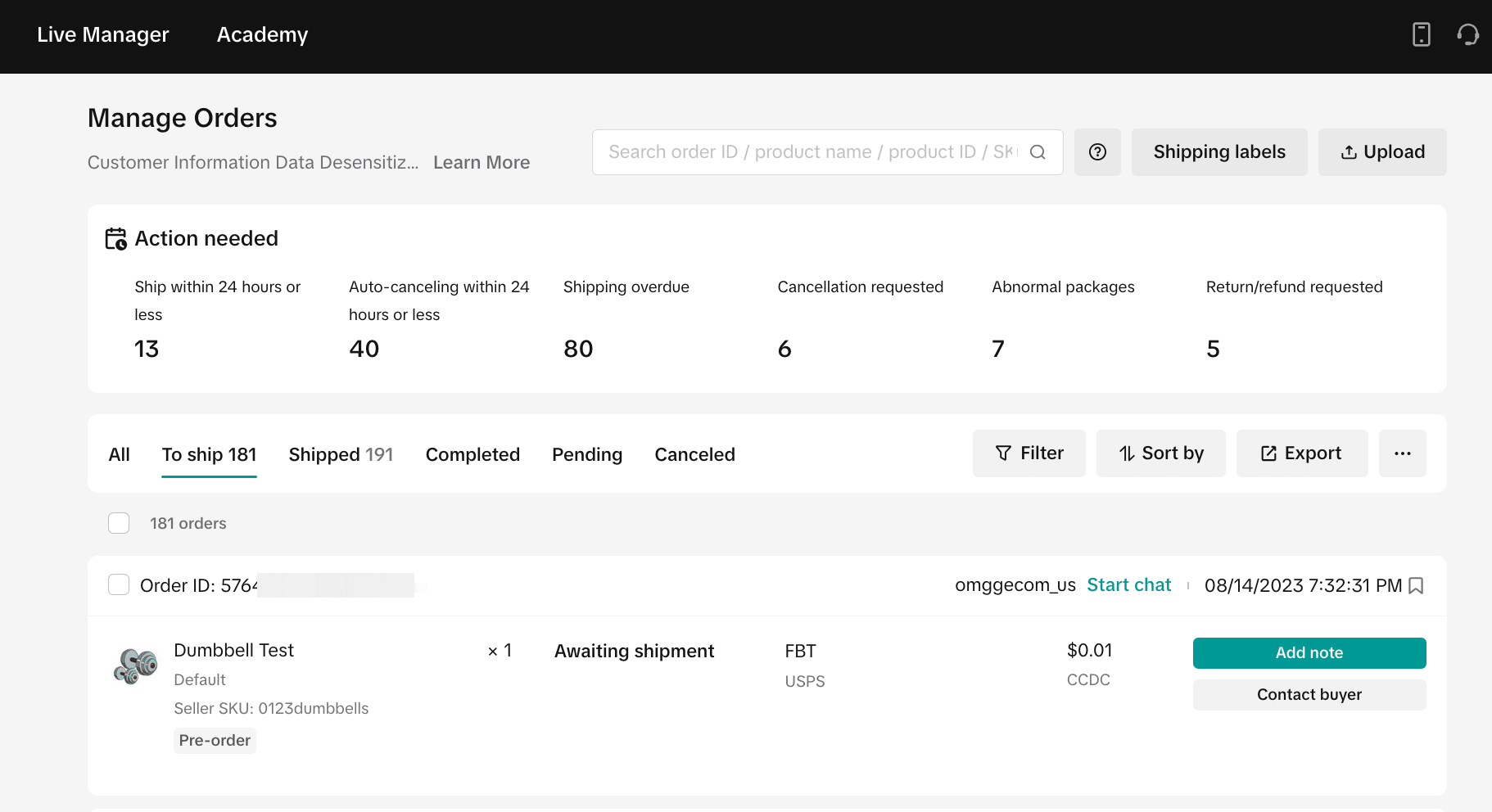
You get to choose who delivers TikTok orders from the following options:
- Seller Shipping: Arrange your own shipment and delivery (provided TikTok supports your logistics partner)
- TikTok Shipping: Choose a provider from the list in the TikTok Shop’s Seller Center
- Fulfilled by TikTok: Outsource the entire shipment process from storage and collection to delivery to the TikTok team
Each option comes with pros and cons. For example, Seller Shipping gives you greater control but means you can’t benefit from TikTok’s discounts and deals.
TikTok lets you ship products globally but its support is limited compared to some alternatives. To expand your reach, it’s best to combine your social media channels with a dedicated ecommerce site. You can access more local shipping options and access more foreign markets without having to give up your TikTok.
How to handle canceled orders
Customers have a one-hour pending period after they’ve placed an order. If they cancel during this time, it’s as if the order was never placed.
After the pending period is over, customers can still make a cancellation request. TikTok should send you a notification with the reason why to your dashboard.
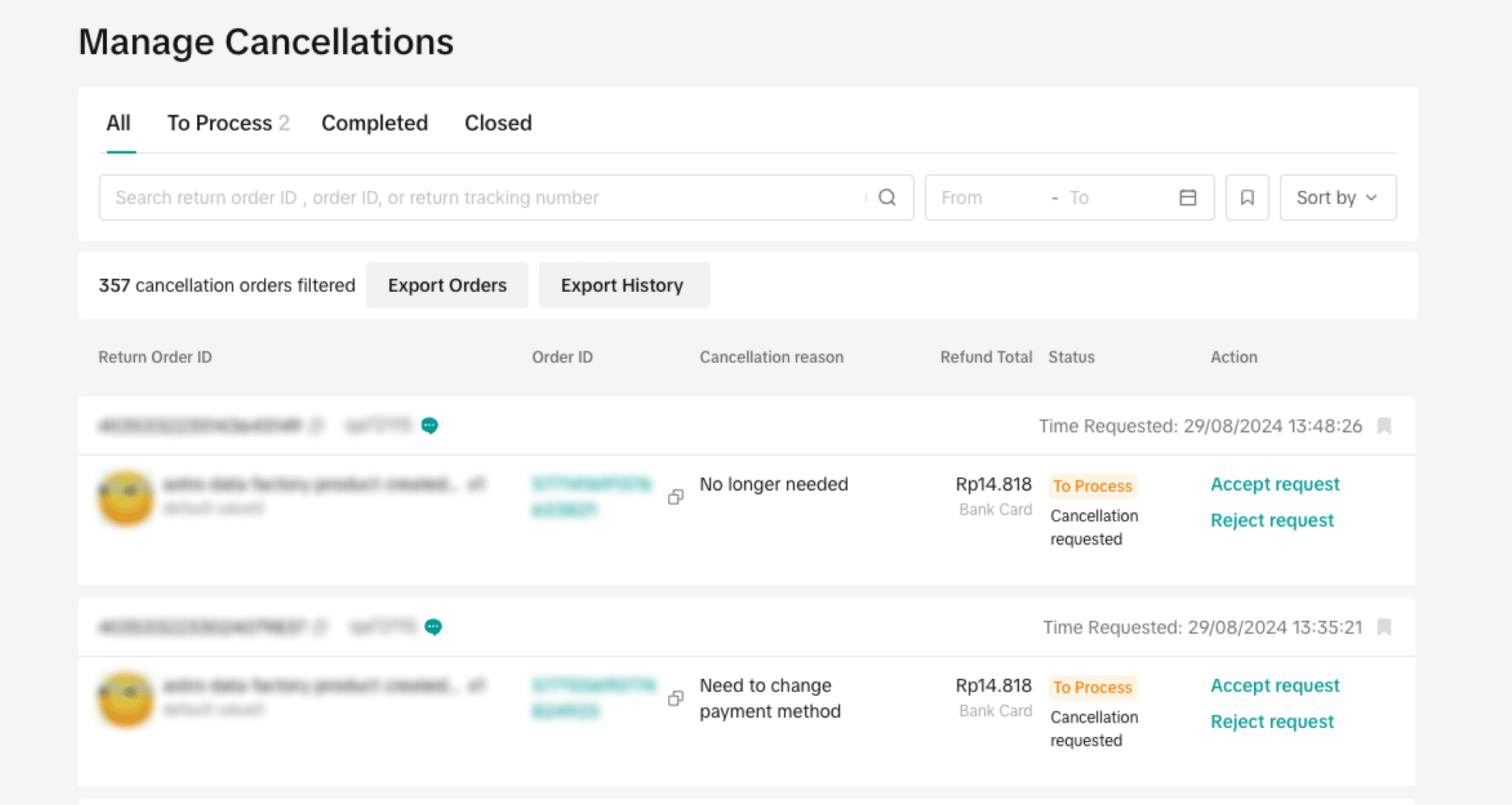
All sellers have 24 hours to either accept the cancellation or reject it and upload the tracking details; Otherwise, TikTok automatically cancels the order. Making a habit of checking your shop every day can help you catch these requests and avoid dealing with unnecessary returns.
Customers may cancel later in the process if you take too long to change the order status or ship the item. It’s best to keep them updated if you anticipate delays via the in-app messenger. Cancelled orders don’t just mean fewer sales — a high rate may affect your shop’s visibility on TikTok.
How to cancel orders on TikTok Shop as the seller
Sometimes you might need to cancel orders yourself due to issues like damaged stock or shipping issues. You must take a different route as the steps above are only for TikTok customers.
When you realize you need to cancel, take the following steps:
- Go to the order management dashboard
- Find the specific order
- Select the drop-down menu on the right side of the box
- Click on cancel
- Give the reason for the cancellation
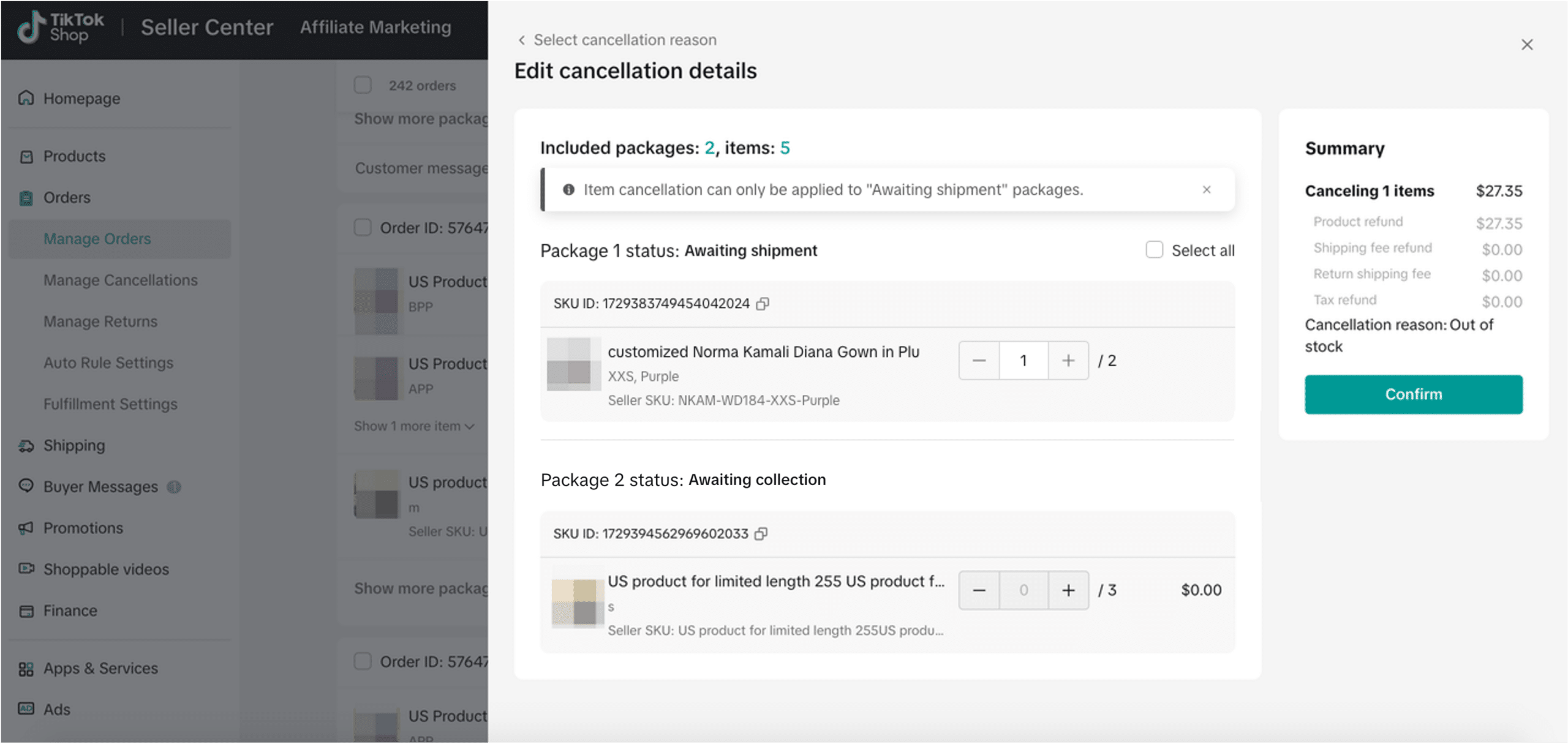
Note that you can’t cancel the order once the status has changed to ‘To Ship – Awaiting Collection’. The parcel is already en route, making it challenging for TikTok to reverse the process.
Before canceling an order, consider whether you can contact the customer to resolve the issue or offer them an alternative. If you can’t ship to their current address, for example, perhaps they can change it to a supported location.
Never ask the customer to cancel the order on your behalf. While this may seem like a way to lower your cancellation rate, it’s against TikTok’s policy.
What about canceling one item out of a big order?
You might get a large order only to realize that some of the items are unavailable. Don’t worry, TikTok doesn’t make you cancel the whole order. You can just select the specific items and remove them.
Otherwise, follow the same steps you would for regular cancellations. You need to contact the buyer, explain what’s happened, and offer a remedy.
How to handle returns and refunds
Around one in ten products bought online get sent back. That means even if you only sell a few items a month, you need to get to grips with refunds and returns.
Customers have 30 days to request a refund from the date the order status changes to ‘Delivered’. After that, they may only raise a claim for damaged or defective goods.
When you get a refund request, what you do next depends on the type of product.
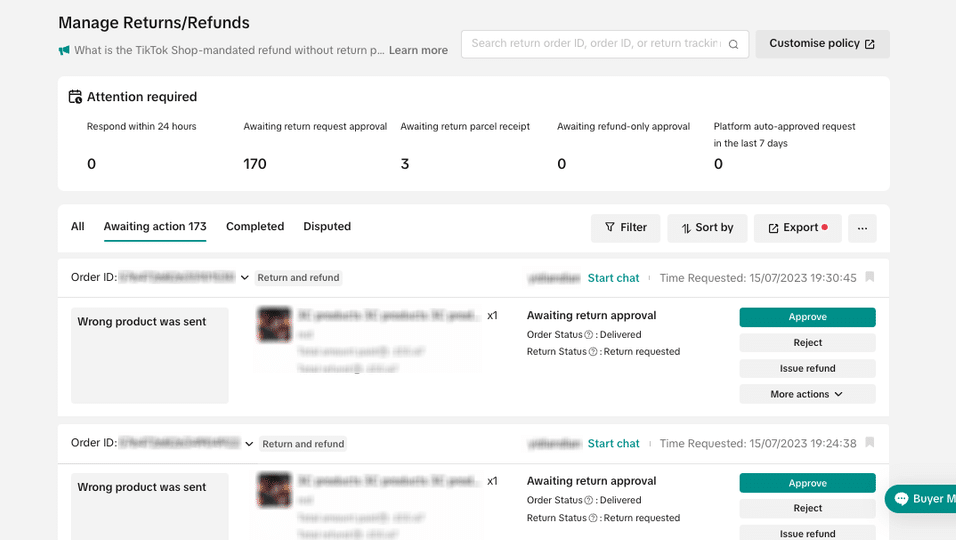
Returnable products
TikTok automatically accepts any customer requests for refunds made within the 30-day limit. Your job is to wait for the return. When you receive the item, you can check the item’s condition and decide whether to approve the refund.
Be quick as you only have two to four days to dispute the refund. Wait any later and TikTok automatically approves the transfer back to the customer.
You’re responsible for paying the shipping costs if you’re found at fault. Otherwise, either the customer or TikTok picks up the bill.
Here’s the good news: Some TikTok users are eligible for refunds without returns on items under $10. You still get fully reimbursed but you don’t need to worry about checking the product or approving the refund.
Non-returnable products
Many products can’t be returned for safety and hygiene reasons. As you might expect, that’s typically perishable items like food or beverages or goods that spoil after a short time.
Sometimes, TikTok might still ask the customer to return high-value items so you can inspect them and approve the refund.
Similar to returnable products, you get two to four days to decide whether to dispute the refund. Any later and TikTok automatically approves it.
How to handle sales tax
Unsure about which rates to use? You can rest easy as TikTok is responsible for remitting sales tax from customers across all the locations where it’s required.
The downside is TikTok remits taxes even when customers qualify for tax-free purchases. You might lose some sales to businesses on other platforms who can offer lower rates.
As you expand your business, it may be worth selling across other channels. Ecommerce sites like Shopify and WooCommerce leave the sales tax management to you, giving you more flexibility and control over orders. Most platforms let you integrate your TikTok Shop to sync all your order, sales, and inventory data. For example, if you’re already running a Shopify store, you can connect Shopify to your TikTok Shop.
What to know about TikTok Shop fees
TikTok Shop is free to use but the platform takes a percentage of each order. The amounts differ vary across locations and product categories but here’s what you can expect:
- Market commission: A small percentage of the order to cover TikTok’s services
- Transaction fee: The charge for payment processing through the platform
- Shipping fee: The cost of delivery if you offer free shipping or bear responsibility for a refund and return
- Affiliate payments: Any commissions you owe creators for promoting your products
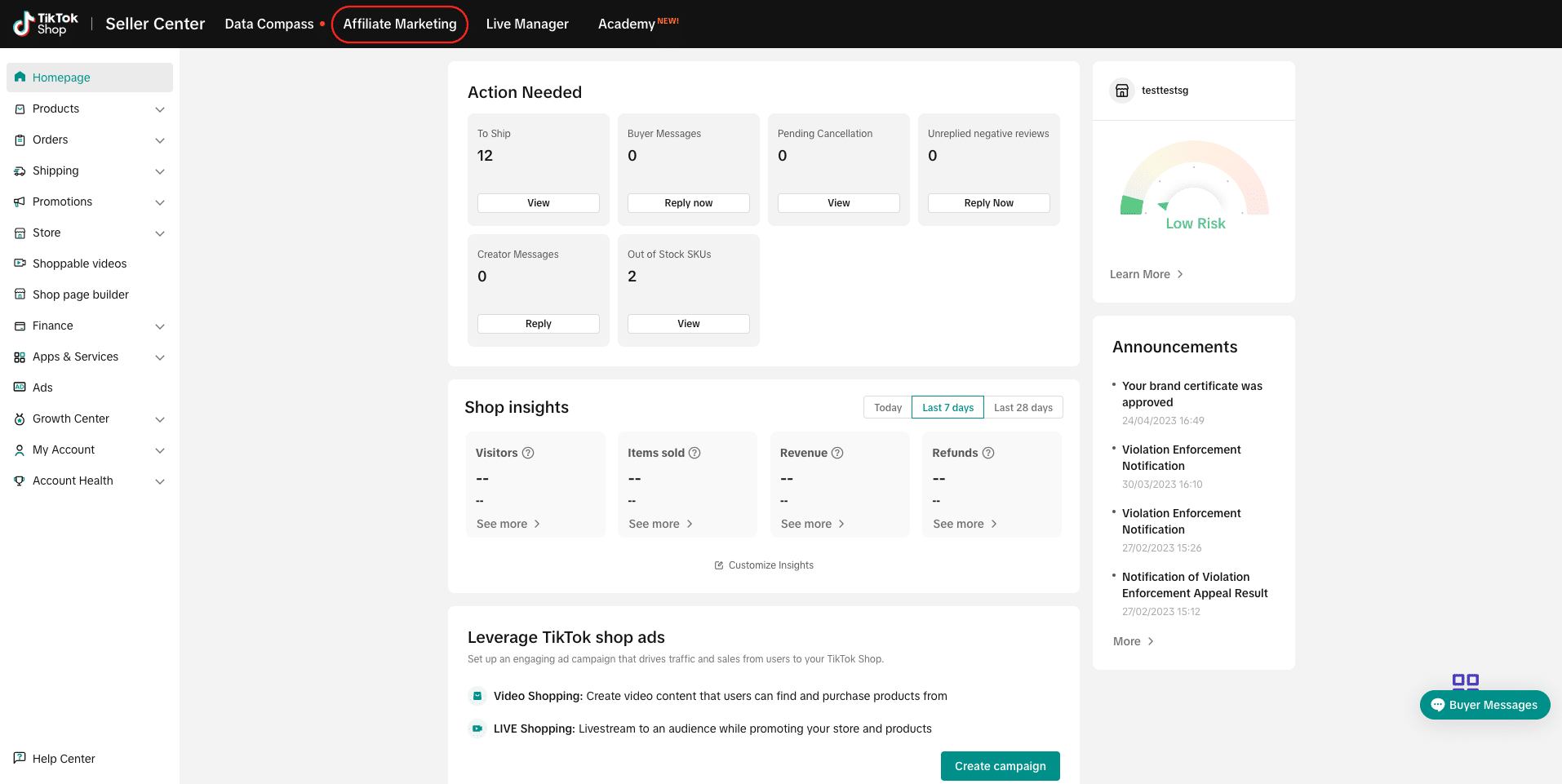
Most of these charges are automatic so you don’t need to worry about transferring them. But shipping fees depend on the method you’ve chosen — you may need to arrange payment to some third-party providers.
When you start out, TikTok’s pricing makes more financial sense as you may only sell a few products. But these fees might cut into your profits as you expand and your sales grow. Look into solutions with a fixed monthly rate rather than relying on TikTok if your side hustle starts to become a full time job.
Tips for making sure TikTok orders get to customers
Understanding and following TikTok’s rules is only half the story. You need to follow some best practices to make sure customers get the products and don’t end up returning them.
Here’s what to bear in mind:
- Make clear product listings: Make sure your description is accurate and detailed and images reflect what items actually look like. This reduces the likelihood of customers getting disappointed and wanting to request returns.
- Track inventory: Actively monitor TikTok products and restock so there’s less danger of you running out of products without realizing.
- Move quickly: Fulfil orders as quickly as possible so customers have less time to overthink their purchase and change their minds.
- Keep customers updated: Tell customers if you’re experiencing difficulties so they know what to expect. They’ll be more satisfied with your service and less inclined to cancel if they know the delivery’s just a little late.
- Take grievances to TikTok: When you suspect the customer has damaged the product, report the issue to TikTok. Be prepared to accept their verdict, though.
- Pick your battles: Even if you’re in the right, sometimes it might be worth offering a refund and accepting the return for minor issues.
- Integrate with the right tools: As you’re running a business, you probably need to report your income and expenses to your local tax authorities. Use dedicated accounting solutions like QuickBooks and Xero to record your financial activities and balance your books.
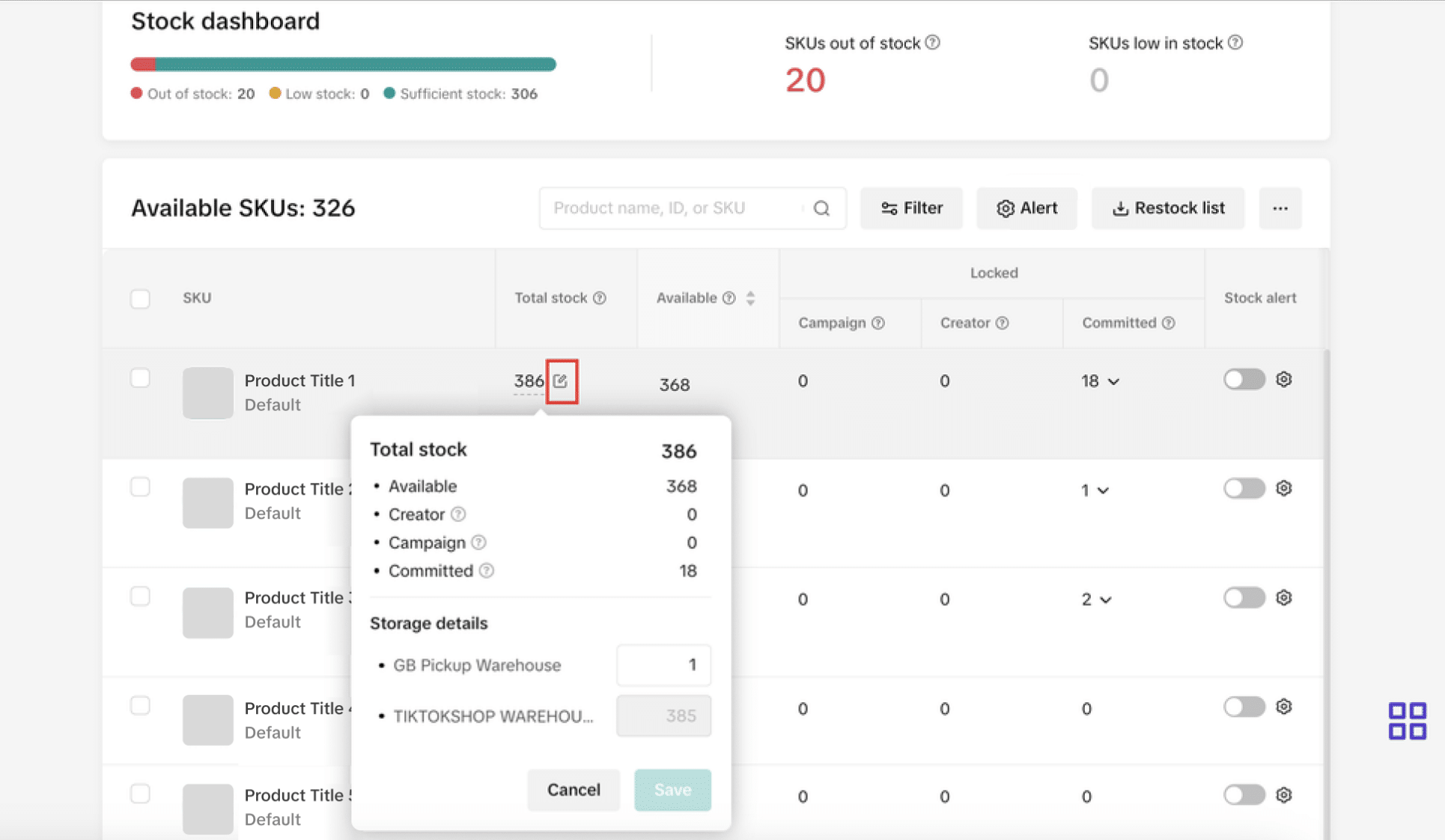
Ready to get more control over the order process?
TikTok Shop’s rules might be a lot to absorb but they provide new sellers with a lot of structure. You don’t have to worry about creating or enforcing policies.
You’re likely to need more control as you expand your operations. That’s when it’s time to move your base of operations from TikTok to a dedicated ecommerce solution like Shopify or WooCommerce.
Ecommerce solutions give you flexibility and control over how you manage orders. You decide how long customers have to request refunds or return unwanted products. But there’s nothing stopping you from selling on TikTok — you can advertise and take orders there while managing your core operations from your new website.
| Record order data no matter where it comes from
MyWorks connects your Shopify or WooCommerce store with your accounting solution to automatically keep sales data up-to-date between ecommerce and accounting. |















